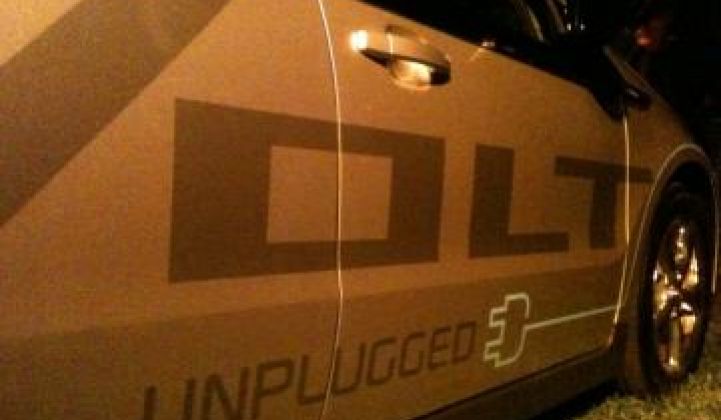Who Killed the Electric Car?, director Chris Paine's renowned documentary about the effort to save GM’s EV1 and Toyota’s RAV-4 EV, left the identity of the culprit an open question, and for good reason: the electric car wasn’t killed; it was wounded. And now, with Nissan’s all-electric Leaf and Chevrolet’s plug-in hybrid electric Volt coming to U.S. showrooms in November, it’s back, healthier than ever.
Plug-In America (PIA), which was born out of the protest to save the 1990s EVs, met at Paine's sprawling hilltop home overlooking Los Angeles Saturday night to celebrate the organization’s fifth anniversary and the triumphant re-emergence of the car with a plug.
There was a profound question lurking behind the crowd’s jubilation as it partied and examined a Leaf and a Volt that were made available by each vehicle's manufacturer. Hanging heavy in the L.A. air was the mystery of whether the enthusiasm and commitment of these visionary early adopters could be transformed into a market-driving majority. To do that, both Paines and PIA have media strategies.
To the crowd’s enthusiastic endorsement, Paine debuted the trailer for The Revenge of the Electric Car, a sequel that documents the passionate people and stormy processes behind the pending introductions of Nissan’s EV and GM’s PHEV.
PIA also debuted a series of public service announcements that will begin airing in November. Utilizing the media savvy and contacts of L.A.-based PIA members like Paine and former Baywatch star Alexandra Paul, the 60-second spots are intended to smooth the E-transition by familiarizing the public with electric transport.
Longtime EV advocate Mark Swain is one of a fifteen-member Customer Advisory Board GM has formed to help win public acceptance. He believes the key to success is to make buying a Volt “as easy as buying a car today. Right now,” he said, “there are a lot of hurdles that people don’t want to jump.” Swain added, however, that the Volt is “one of the most technologically amazing cars I’ve ever seen” and “once it gets out in the world,” he said, “people will like this car.”
As a template for the transition, PIA Legislative Director Jay Friedland referred to the track record of Toyota’s Prius. “When someone bought a Prius,” he said, “you would then see an entire neighborhood go out and buy Priuses.” He foresees a million plug-in cars on U.S. roadways before 2020 and added that any spike in gas prices will accelerate uptake.
Friedland said the options of a pure EV and a PHEV will make the transition easier by giving buyers the opportunity to select the car that suits them best. And, he pointed out, “these are just the first two of 25 cars that will be introduced over the next two years.” Whether the EV or PHEV will prevail, he said, “is all crystal ball right now.”
PIA President Dan David ticked off the advantages of a plug-in vehicle. “It’s cleaner, it’s less expensive to operate, it’s running on domestic energy sources, it’s quiet and it’s powerful,” he smiled. “Once more people in the public experience that, well, Katie, bar the door.” He predicted that demand will outstrip supply for the foreseeable future. He expects EVs to account for at least ten percent of new car sales by 2020.
A.P. van Deventer, a Dutch government researcher, has studied the challenges and opportunities of electric transportation in order to advise his country’s political leaders. The Netherlands, he said, aspires to have a million EVs on its roads by 2025. Recently, van Deventer examined why EVs failed to reach U.S. markets in the 1990s.
He found that the reasons were essentially those reported in Paine's film, although one was overlooked. “What really needs to be done is to make sure all stakeholders are involved,” he cautioned. “Otherwise, you create resistance,” as happened in the '90s. “GM didn’t want it, oil didn’t want it,” he said. “And by the time the mandate was decided,” he added, “it was let go too easily. You have to have long-term vision.” The coming E-transition, he said, “is going to take 20 to 30 years.”
Paine explained why he believes electric transport will succeed this time around. “This is the first time,” Paine said of the buying public, “they’ve ever had a chance to make this decision. Even the California cars that were available when we all found out about them were very difficult to get. This is the first time in a hundred years that 99.9 percent of drivers have the option to drive something that isn’t an oil-based car.”
Having spent the last few years interviewing the people who will lead the transition, Paine foresees short-run action. “I think the Volt and the Leaf, in the limited production numbers that they are doing, are going to sell right out.” When the marketplace opens up in 2012, however, it “is going to be a whole new ball game.” Early adopters in 2011 will “prove the cars work in their lives just like they did for this nucleus group here” and “that will propel what happens in 2012.”
As to the speed of the transition in the long run, Paine sees two possibilities. “Nobody knows how fast it is going to happen, but when gas prices spike, it will happen really fast. If gas prices stay artificially low for a while, it will happen more slowly.” But, he said, “this will roll out.
Interested in eleictric cars and smart grids? Attend The Networked EV on Nov. 9, 2010 in San Francisco, CA to learn about the intersection of the two industries.



